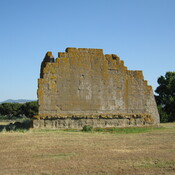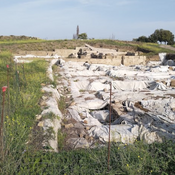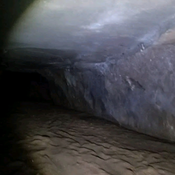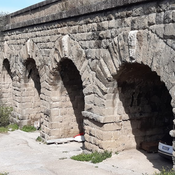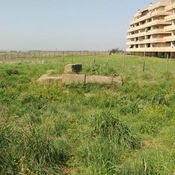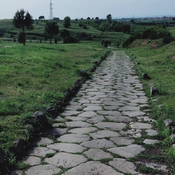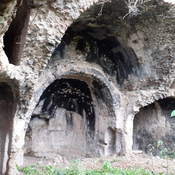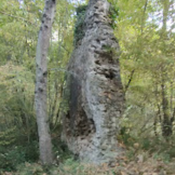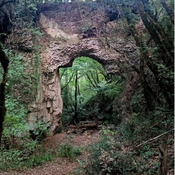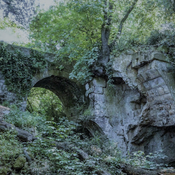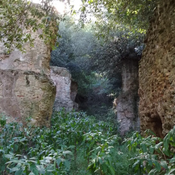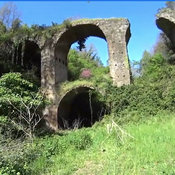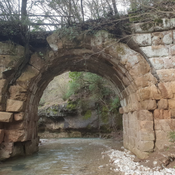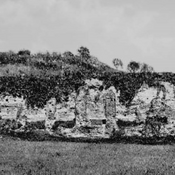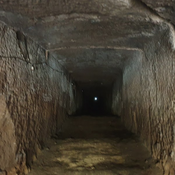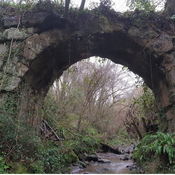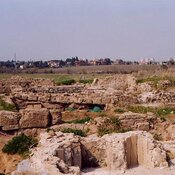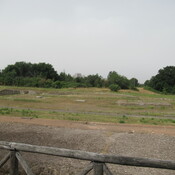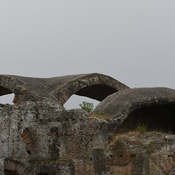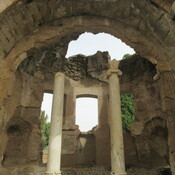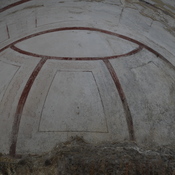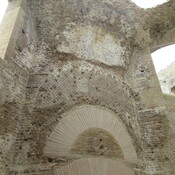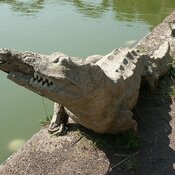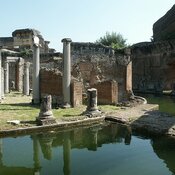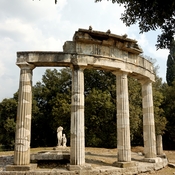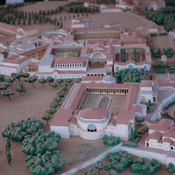Gabii (Oudgrieks: Γάβιοι / Gábioi) was een oude en eenmaal machtige stad van Latium, en een kolonie van Alba Longa.
Zij werd volgens de overlevering door Tarquinius Superbus op verraderlijke wijze veroverd. Later heeft Rome met Gabii een verbond gesloten, waarbij de burgers onder de cives Romani werden opgenomen, maar Gabii zijn eigen gemeentebestuur behield. In Cicero’s tijd was het stadje geheel vervallen. De steengroeven van Gabii leverden de bouwstof tufsteen (bij de Romeinen soms tophus, tegenwoordig peperino geheten), tot de herbouw van Rome na de grote brand onder keizer Nero.1
Zie ook
Bronverwijzingen
- ↑Wikipedia: Gabii
Gabii was an ancient city of Latium, located 18 km (11 mi) due east of Rome along the Via Praenestina, which was in early times known as the Via Gabina. It was on the south-eastern perimeter of an extinct volcanic crater lake, approximately circular in shape, named the Lacus Gabinus, and then during later times called the Lago di Castiglione, "lake of the fortification", after Castiglione, a mediaeval tower erected on the site of the ancient acropolis, or arx, of Gabii. A necropolis is adjacent on that side of the lake. At present, the former lake is entirely agricultural land. The ruins of the ancient city project from the fields next to the cliffs overlooking it, on both sides of the via.
The early date of the prehistoric Gabii suggests that the Roman writers could have little traditional memory of its foundation or of who founded it. The surviving traditions are therefore in the legend category; there may or may not be elements of truth in them. The tradition is two-fold: Gabii was founded either by the Latin kings of Alba Longa (according to Vergil and Dionysius of Halicarnassus) and therefore was aboriginal Latin in ethnic descent, or by the Sicels as the Siculi, a substrate population of east Italy expelled by the Italics to Sicily. They became one of the three major indigenous tribes of ancient Sicily, giving their name to it.
The legend of a Siculian foundation of Rome comes from fragments of early Roman annalists, who asserted that the Siculi occupied several cities of Latium before the arrival of the aborigines (Latins): Rome, Tibur, Fescennium, Falerii, Antemnae, Caenina and a few others. Gabii is mentioned as one of them by Gaius Julius Solinus. According to him two Siculian brothers founded it and named it by combining their names, Galatus and Bins. Fanciful etymologies such as the above are not taken seriously but there is a sober case for a Sicilian and Siculian influence on early Latium. For example, the Cloelii claimed to be from Alba Longa and used the cognomen Siculus. Prisons called lautumia were cut into the sides of the early Capitoline Hill. Syracuse used quarries, called latomiai, for a simuilar purpose. Most of the similarities can be attributed to an influence on early Rome from Greek Sicily; however, the case of a Sicul substrate also is possible.
Plutarch relates the legend that Romulus and Remus were raised by Faustulus, the servant of Amulius, in Gabii, where they learned everything from literature to the use of Greek weapons. From there they went on to found Rome.
The Latin League (Latini) was brought under Roman jurisdiction by the last king of Rome, Lucius Tarquinius Superbus. Addressing their council and claiming that, because all the Latin cities were founded from Alba Longa and Servius Tullius had made a treaty by which Alba was ceded to Rome along with all its colonies, Rome had a legal claim over the Latins, he offered them protection from any chance devastation that should inflict their country and a share in Roman prosperity if they would resume the treaty, which they did. Thenceforward Latin troops fought beside Roman within the Roman army.
Gabii reneged from the Latin treaty with Rome for unknown reasons. Tarquinius' son, Sextus Tarquinius, went to Gabii, pretending to be in revolt against his father and asking for assistance.
He was accepted, and after successfully commanding various military expeditions, he was appointed as the leading general of the army of Gabii. As general, he commanded a number of minor but successful skirmishes against Roman forces, with the complicity of the Roman king.
He sent a message to the king asking what to do next. Receiving the messenger in the garden the king said nothing at all (for which he might have been held liable later) but strolled around lopping off the heads of the tallest poppies with a stick. Sextus took this to be a message to destroy the aristocrats of Gabii. After Sextus had destroyed or exiled the chief men of Gabii by various means, soon afterwards the city of Gabii was surrendered to the Roman king without battle.
Dionysius of Halicarnassus states that Tarquin was lenient with Gabii, and their subsequent treaty, whose original text was written on a bullock's skin and draped over a wooden shield, was said by Dionysius of Halicarnassus to be still extant in his day in the Roman temple of Sancus.
After the overthrow of the Roman monarchy, Sextus fled to Gabii but was killed by the leaders of the city in revenge for his past actions.
Gabii was an ally of Rome after 493 BC. In the late Republican period, the city became depopulated due to the extensive use of the lapis Gabinus quarry, which was just under the archaic city. Cicero mentioned it in the 1st century BC as a small and insignificant place.
The Augustan poets used Gabii when demonstrating a city that had fallen from its old heights. From inscriptions we learn that from the time of Augustus or Tiberius onwards it enjoyed a municipal organization. Its baths were well known, and Hadrian, who was responsible for much of the renewed prosperity of the small towns of Latium, appears to have been a very liberal patron, building a senate-house (Curia Aelia Augusta) and an aqueduct.
After the 3rd century, Gabii practically disappears from history, though its bishops continue to be mentioned in ecclesiastical documents till the close of the 9th century.1
External links:
Lapis Gabinus: official blog of the Gabii Project
Bronverwijzingen
- ↑Wikipedia: Gabii



